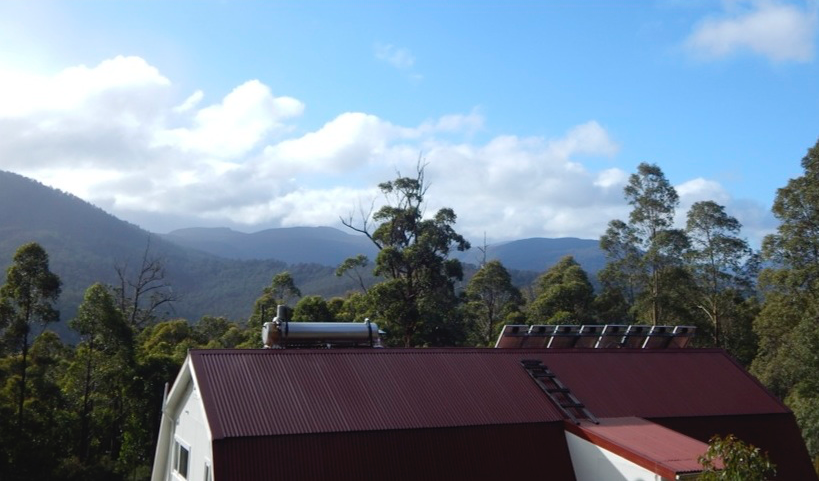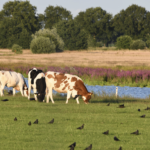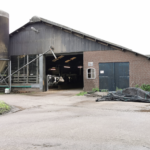(First published on February 8, 2017)
Benjamin Richardson
(Professor of Environmental Law, University of Tasmania; Tilburg University’s Global Law Visiting Chair 2017)
In early 2015 my wife and I purchased 66 acres of wild landscape in our homeland, Tasmania, and set about ensuring its indefinite protection by putting a conservation covenant on the property title. With this legal protection to “Blue Mountain View”, as we call our land, we joined other like-minded neighbours committed to safeguarding this beautiful niche in Tasmania’s Huon Valley. We have also since participated in some wildlife monitoring projects with environmental groups to better understand the local biodiversity and thereby facilitate long-term conservation planning.
Blue Mountain View, Tasmania (photo: B. Richardson)
Becoming an environmental steward with legal responsibility to protect and improve the ecological values of a small piece of our planet is a great privilege, providing exceptional opportunities to forge a more intimate relationship with, and knowledge of, the natural world. This experience reminds me of the writings of Harvard biologist Edward O. Wilson who hypothesized that human beings possess biophilic tendencies.[1] Yet biophilia, like other affections, is unlikely to flourish if not nurtured. If our experience of nature is limited to desolate landscapes with few wildlife beyond the ubiquitous rats, pigeons and common weeds, we are unlikely to appreciate nature’s richness and beauty. Equally, if our daily lives are spent amidst car parks and shopping malls, we will hardly understand the complexity of ecosystems and the need to care for them. In our highly urbanized, consumer lifestyles, the impoverished opportunities for direct interactions with wild places are one of the principal obstacles to making environmental conservation a social priority.
My association with Blue Mountain View has enabled me to acquire much greater ecological literacy than I ever gained from just reading literature and watching nature films. I have come to learn much about the habits of rare or engendered species that inhabit it, such as Tasmanian Devils and Eastern Quolls, and develop a greater sensitivity to nature’s temporalities as observed from the fruiting and flowering of vegetation or the seasonal migration of birds.
Tawny frogmouth, Blue Mountain View (photo: B. Richardson)
But how can we engage the general public with the natural world so as to similarly build ecological literary, respect and affinity? This is a multidimensional task of which environmental law can only play a part.[2]
A key strategy must be community participation in ecological restoration, the practice of repairing historic or recent damage to landscapes and seascapes. The practice is evoked by the work of New York artist Alan Sonfist. He erected numerous monuments in cities around the globe to commemorate and “heal” their lost ecology. His archetypical work is “Time Landscape”, constructed over 1965 to 1978 in Manhattan in cooperation with the City Botanical Gardens. His “landscape” recreated the original indigenous vegetation of New York on an empty street corner in Manhattan, and the living artwork evokes the processes of nature reclaiming itself. Serious ecological restoration, of course, must be tackled on a much grander scale.
Restoring nature is vital to defend against the upheavals of the Anthropocene. We shouldn’t assume that sustainability – the dominant goal of modern environmental law – is achievable using current environmental conditions as baselines for legal protections because those conditions are often too degraded to meaningfully sustain. Instead, attaining sustainability may also require some recapturing of prior ecological conditions – lands may need to be replanted with vegetation, fish stocks replenished, and landscapes cleansed of contaminants.
Southwest Tasmania’s world heritage (photo: B. Richardson)
The law must prioritise ecological restoration, a task that will require a major shift from current legal precedents. Major environmental legislation in most countries offers few provisions devoted to this task, mostly focusing on remediation of contaminated brownfields or former mines rather than restoration of entire ecosystems.[3] Fortunately, the governance deficits are starting to be filled by some fascinating initiatives from non-state actors, namely environmental NGOs, community groups, farmers and Indigenous peoples, collaborating voluntarily to restore and rewild nature.[4]
The examples include Gondwana Link, restoring a 1000 km stretch of Western Australia that suffered catastrophic land degradation from misguided farming. Began in 2002, the project aims to reconnect fragmented natural habitats to create a holistic ecological system, through outright purchase of high priority lands and conservation covenants on other properties that are then subject to various restorative interventions.[5] In North America, the Y2Y project – denoting Yellowstone to Yukon – is using a similar approach to Gondwana Link, except over a bigger scale along the Rocky Mountains and involving more jurisdictions and actors. In New Zealand, which has suffered among the world’s worst biodiversity loses – don’t believe the deceptive “100% Pure” slogan that the country advertises – restoration has been led by community groups sometimes in partnership with government land managers. They are creating huge fenced sanctuaries in which exotic vermin are removed to allow the remnant avifauna to regenerate.[6] And in Scotland a charity called Trees for Life is restoring 230,000 hectares of the ancient Caledonian forest that was grazed and logged to near destruction several centuries ago.[7]
Another approach, better suited to urban denizens, is called “reconciliation ecology”. The term was apparently coined by Michael Rosenzweig to describe restoration projects that benefit people by drawing them closer to their natural environs, including providing aesthetic and recreational benefits.[8] Such reconciliation often takes place in urban areas to bring nature closely into people’s daily lives, such as expanded city parks, restored waterways, and green roofs. One outstanding example is “Zealandia”, a restored bird-rich sanctuary, located near the heart of Wellington, the capital city of New Zealand. Through reconciliation activities, people become more aware of their degraded environs, the opportunities to improve them, and thereby hopefully acquire greater ecological literacy.
‘Citizen science’ is another movement that touches on similar ideas but uses different methods. Citizen science projects involve lay people participating in environmental monitoring to help researchers understand environmental baselines and changes that can then feed into management actions including restoration. Citizen science taps into a valuable community resource while enhancing participants’ ecological knowledge and commitment. Citizen science projects include tracking marine plastic debris[9] and counting birds.[10] Advances in information technology, both in recording and sharing the data such as GPS and remote camera ‘trapping’, have greatly expanded opportunities for citizen science to recruit larger audiences of volunteers. I have been involved in one such project on Blue Mountain View recently.
Trees in heaven, Blue Mountain View (photo: B. Richardson)
But such community-based initiatives aren’t enough. Volunteerism may not be sustainable in the absence of reliable funding, may lack influence when confronted with uncooperative landowners, and may be undermined by antagonistic government policies and regulations that enable inappropriate economic developments. For instance, some Australian states have enacted recent legislative changes that make it easier for landowners to clear native vegetation.[11]Environmental lawyers must advocate ways for governments to play a more positive role, while preserving community initiative. Such roles could include more generous seed funding and tax breaks, coupled with reforms to land use planning and inclusion of stewardship obligations in all property tenures. Legislative mandates for sustainability should also be redefined to include obligations for restoration and reconciliation where existing ecological baselines are too degraded.
Of course, social change will require more than just law. The arts can also play a special role in enlivening people’s imagination and building their commitment to restoring nature. German artist-entrepreneur Dirk Fleischmann’s project “My Forest Farm” is one of the most ambitious artworks that illustrate this stance. The zero-carbon footprint art “work” is a voluntary carbon–offset program in the form of a reforestation initiative in the Philippines. In 2008, Flesichmann began planting nearly 2,000 trees on four acres with the aid of the local community. His project aims to challenge the booming carbon offset-market which he believes wrongly simplifies the issues of climate change by pretending that the problem of greenhouse emissions can be solved simply by purchasing offsets (an efficient transactional mechanism suited to busy people with no time to contemplate the environmental issues at stake). My Forest Form reveals the complexities and time-consuming process of carbon-dioxide sequestration. Although his project results in carbon off-setting, he does not offer the carbon credits for sale. Instead, Fleischmann offers art – each of the trees is photographed and its GPS location recorded, and then exhibited in galleries and sold via the project website for 10 euros each. The earnings help fund the reafforestation project and educate the public about nature’s time-scales.
Dragonfly – austrogomphus guerini, Blue Mountain View (photo: B. Richardson)
In conclusion, when reflecting on the roles of environmental restoration and reconciliation, we should appreciate that it is not just about improving nature but also improving human society. Restoring damaged ecosystems is not a viable long-term proposition if humankind remains emotionally and cognitively detached from its natural environs. Without inculcating greater ecological literacy, society will likely just repeat its past mistakes and undo any gains from new restorations. Participation in restoration projects can help communities understand their place in the deep time-scales of Earth’s landscapes, and may help nurture their biophilic impulse. Not everyone can elope to a place like Blue Mountain View, but we should all have some opportunities to engage with and learn about nature in which we are embedded and dependent like a cell within a body.
[1] Edward O. Wilson, Biophilia (Harvard University Press, 1984).
[2] See further Benjamin J. Richardson, Time and Environmental Law: Telling Nature’s Time (Cambridge University Press, 2017): in press.
[3] Margaret A Palmer and JB Ruhl, “Aligning Restoration Science and the Future of Law to Sustain Ecological Infrastructure for the Future” Frontiers in Ecology and the Environment 3(9) (2015): 512.
[4] Benjamin J. Richardson, “Reclaiming Nature: Eco-restoration of Liminal Spaces” Australian Journal of Environmental Law 2(1) (2016): 1; Caroline Fraser, Rewilding the World: Dispatches from the Conservation Revolution(Picador, 2009).
[5] Keith Bradby, Amanda Keesing and Grant Wardell-Johnson, “Gondwana Link: Connecting People, Landscapes, and Livelihoods Across Southwestern Australia” Restoration Ecology 24(6) (2016): 827.
[6] Dave Butler, Tony Lindsay and Janet Hunt, Paradise Saved (Random House, 2014).
[7] Adrian Manning, David Lindenmayer and Joem Fischer, “Stretch Goals and Backcasting: Approaches for Overcoming Barriers to Large-scale Ecological Restoration”, Restoration Ecology 14(4) (2006): 487.
[8] Michael Rosenzweig, Win-Win Ecology (Oxford University Press, 2003).
[9] Paul E Duckett and Vincenzo Repaci, “Marine Plastic Pollution: Using Community Science to Address a Global Problem” Marine and Freshwater Research 66(8) (2015): 665.
[10] Jeremy Greenwood, “Citizens, Science and Bird Conservation” Journal of Ornithology 148 (2007): 77.
[11] E.g., Biodiversity Conservation Act 2016 (New South Wales); Sustainable Planning Act 2009 (Queensland).class=WordSection2>



